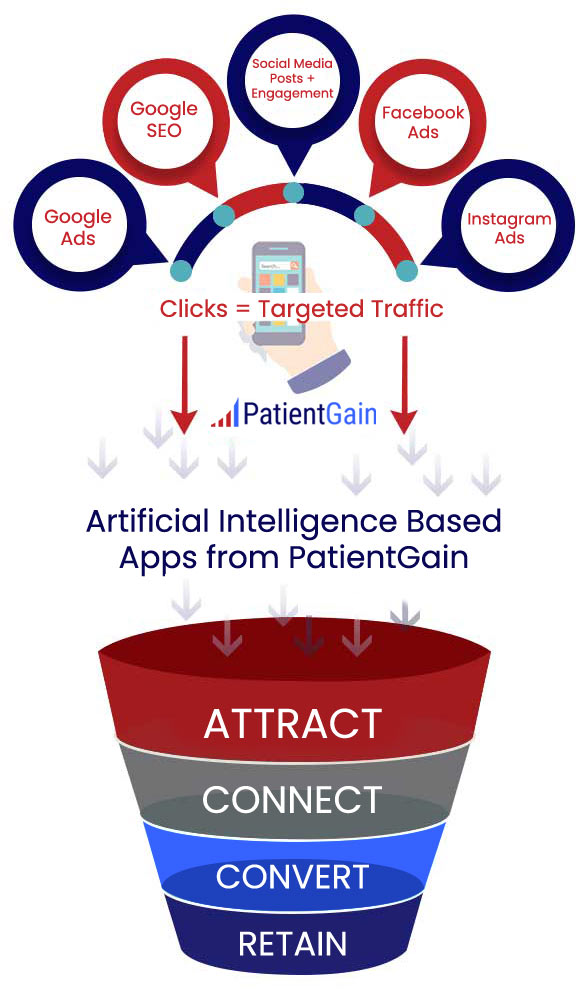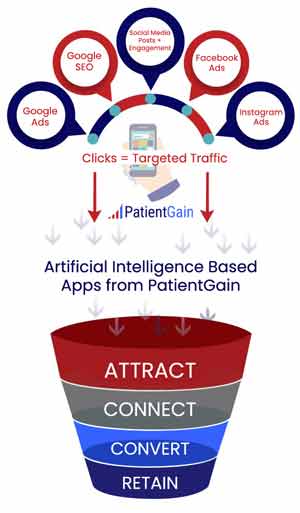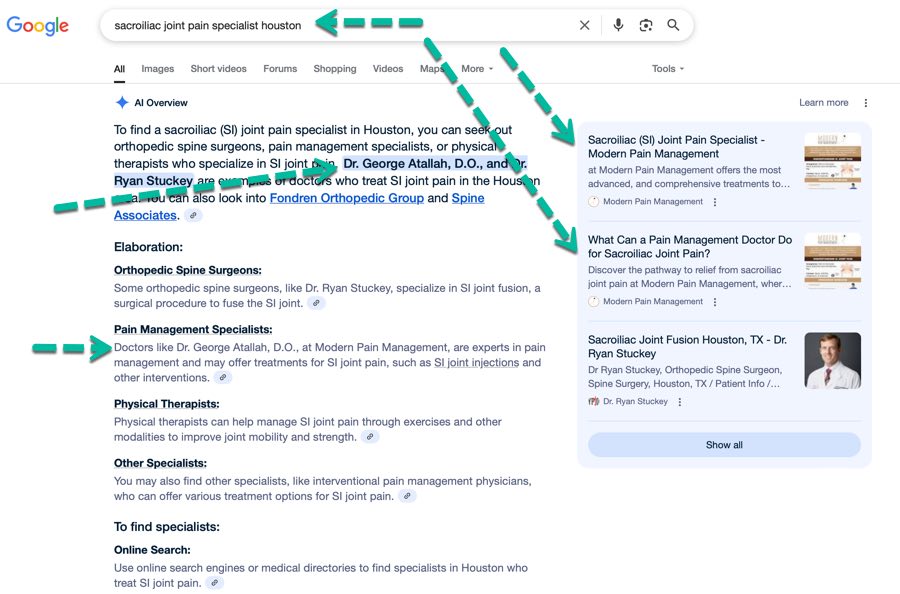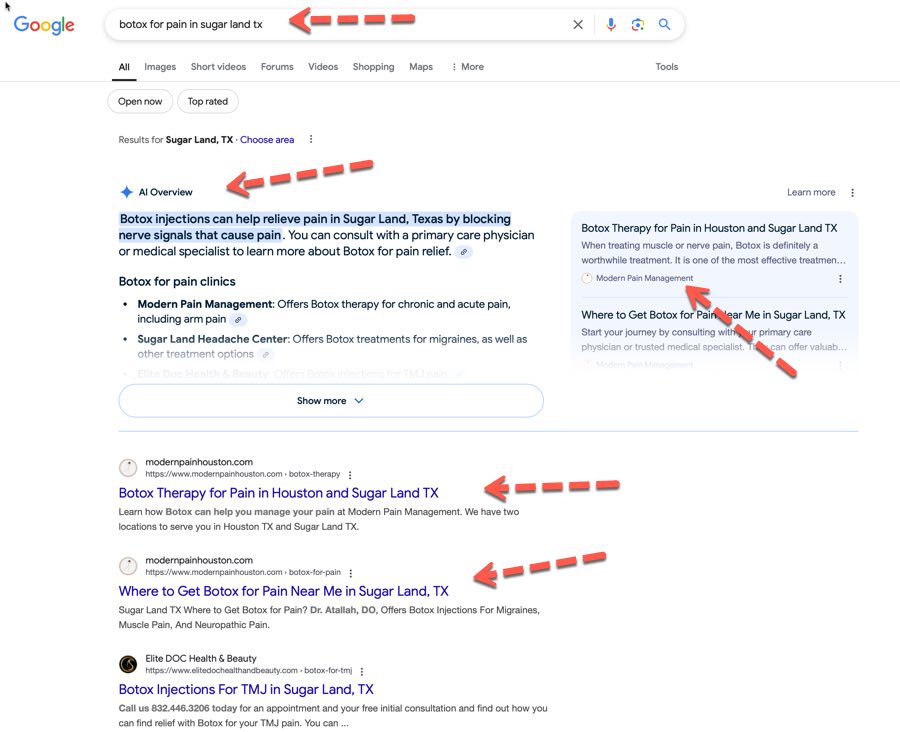Home » SEO For Pain Clinics
You cannot copy content of this website, your IP is being recorded.
Expert Medical SEO For Pain Management Clinics with Examples $999/mon
SEO (Search Engine Optimization) for pain management clinics focuses on optimizing websites to rank higher in search engine results pages (SERPs) like Google, helping potential patients find them online. This involves a comprehensive strategy including keyword research, website optimization, content creation, and local SEO. Key components of Medical SEO specifically tailored for pain management clinics. The goal is to enhance online visibility, attract relevant patients actively seeking pain relief solutions, and establish the clinic as a trusted authority in its specialty and geographic area.
1. Specialized Keyword Research & Strategy
- Understanding Patient Intent & Specific Conditions: This is foundational. PatientGain.com stresses the importance of going beyond broad terms to capture patients actively searching for solutions.
- Examples (Pain Management): “Chronic lower back pain specialist [City],” “non-invasive treatment for knee arthritis [City],” “migraine relief options [Your Town],” “median nerve block for carpal tunnel,” “best doctor for neuropathy pain in [Region].” PatientGain.com highlights identifying keywords that potential patients use when they are “ready to make an appointment or learn more about a specific medical service.”
- Long-Tail Keywords for High Intent: Targeting phrases that indicate a patient is further along in their decision-making process.
- Examples: “Cost of spinal cord stimulator implant [City],” “what to expect after an epidural steroid injection,” “pain management doctor accepting [Insurance Provider] in [City].”
- Competitor Analysis: Understanding what keywords competitors are ranking for and identifying opportunities. PatientGain.com AI SEO agent performs this by offering “competition analysis.”
- Location-Based Keywords: Essential for attracting local patients.
- Example: PatientGain.com’s emphasis on Local SEO underscores the need for keywords like “[City] pain clinic,” or “interventional pain specialist [Neighborhood].”
Example 1: SEO of a practice in Texas. A patient is looking for sacroiliac joint pain specialist in Houston TX. An important part of Google SEO is AI based search results. You can see that Google AI SEO is recommending that user consider certain provider. This is an example of a very good SEO for a pain management clinic.
Example 2: SEO of a practice in Texas. A patient is looking for a pain clinic with botox as a pain remedy. You can see that Google AI SEO is recommending that user consider certain provider. This is an example of a very good SEO for a pain management clinic.
2. Robust Local SEO – A Core Offering of PatientGain.com
- Google Business Profile (GBP or GMB) Optimization & Management: PatientGain.com explicitly mentions “Google My Business (GMB) Management.”
- Accuracy & Completeness: Consistent clinic information(Name, Address, Phone), comprehensive service listings (e.g., “facet joint injections,” “radiofrequency ablation,” “regenerative medicine for pain”), high-quality photos/videos.
- Google Posts & Q&A: Regularly updating with clinic news, educational content, and proactively managing the Q&A section. PatientGain.com’s services include 20 posts on GMB per month.
- Review Management: Actively using Reputation management app for patient reviews on GBP.
- Location-Specific Website Pages: If a clinic has multiple locations, creating unique, optimized pages for each one is crucial, a strategy PatientGain.com would support for better local targeting.
3. On-Page SEO Optimization (Fundamental to PatientGain.com’s “Content & Technical SEO”)
- Optimized Title Tags & Meta Descriptions: Crafting compelling, keyword-rich titles and descriptions for every important page.
- Example: For a page on “Sciatica Treatment,” the title might be “Effective Sciatica Pain Relief & Treatment in [City] | [Clinic Name].”
- Header Tags: Structuring content logically with headers that naturally incorporate keywords.
- Content Optimization for Services & Conditions:
- Service Pages: Detailed, unique pages for each specific pain condition treated (e.g., “Fibromyalgia Management,” “Complex Regional Pain Syndrome (CRPS) Care”) and each procedure offered (e.g., “Platelet-Rich Plasma (PRP) Therapy,” “Kyphoplasty”). PatientGain.com emphasizes “high-quality content related to every aspect of your medical practice.”
- Physician Bio Pages: Highlighting individual doctors’ expertise, specializations within pain management, board certifications, and philosophies of care.
- Image Optimization: Using descriptive alt text for all images.
- Internal Linking: Strategically linking relevant pages to distribute authority and guide users and search engines.
4. High-Quality, Authoritative Content – Emphasizing E-E-A-T – PatientGain.com highlights “High-Quality Content”
- E-E-A-T (Experience, Expertise, Authoritativeness, Trustworthiness): This is paramount in medical content. Content must be accurate, patient-focused, and demonstrate deep expertise.
- Your content must be authoritative, trustworthy, and provide a good user experience.”
- Patient Education Focus: Creating content that answers common patient questions, explains complex medical terms simply, and details treatment pathways.
- Examples: Information pages like “5 Common Causes of Chronic Neck Pain and How They’re Treated,” “Preparing for Your Interventional Pain Management Procedure,” “Understanding the Difference Between Acute and Chronic Pain.” PatientGain.com states, “Content should be focused on educating patients and providing them with useful information.”
- Condition-Specific & Treatment-Specific Deep Dives: Creating comprehensive resources on conditions like neuropathy, arthritis, or specific treatments like spinal cord stimulation.
- Author Bios & Medical Review: Clearly attributing content to qualified medical professionals or linking to good websites.
- Citing Reputable Sources: Linking to authoritative medical studies or health organizations.
5. Technical SEO
- Website Speed & Performance: Ensuring fast load times for better user experience and SEO. PatientGain.com specifically focuses on mobile site speed, as majority of your patients visit from a mobile device. Your medical mobile website should load within 4 seconds per Google’s speed test.
- Mobile-Friendliness (Mobile-First Indexing): A non-negotiable. The website must be fully responsive. PatientGain.com’s platform is typically built with mobile-first in mind.
- Crawlability & Indexability: Ensuring search engines can efficiently find and index all important content (XML sitemaps, well-structured navigation, robots.txt).
- Secure Website (HTTPS): Essential for trust and as a ranking signal. PatientGain.com websites are HTTPS compliant.
- Structured Data Markup (Schema): Implementing schema for
MedicalClinic, Physician, MedicalCondition, MedicalProcedure, FAQPage, etc., helps search engines understand content context and can lead to rich snippets. PatientGain.com incorporates advanced schema.
6. Building Authority through Link Building
- High-Quality Backlinks: Earning editorially given links from reputable sources like local health organizations, relevant medical societies, community partners, and high-quality directories. Avoid buying links and exchanging links.
- Content Promotion: Actively promoting valuable content to attract natural links.
- Local Partnerships: Collaborating with other local healthcare providers or community organizations can lead to valuable local signals and links.
- Encouraging Patient Reviews: Implementing systems to ethically request reviews on key platforms. PatientGain.com offers tools to “get more positive reviews.”
- Showcasing Testimonials: Featuring positive patient stories (with explicit consent) on the website to build social proof and trust.
8. Measuring & Tracking Performance – PatientGain.com provides live HIPAA compliant dashboards to measure conversion and trends.
- Google Analytics & Google Search Console: Built in API integration to Google analytics and search console for tracking organic traffic, keyword rankings, user behavior, technical issues, and conversion actions.
- Key Performance Indicators (KPIs):
- Organic traffic volume and quality.
- Keyword ranking improvements for targeted terms (especially local and condition-specific).
- Local Pack visibility (Google Maps).
- Click-Through Rates (CTR) from search results.
- Conversion rates (e.g., appointment requests from organic traffic, phone calls from GBP).
- Online review quantity and sentiment.
- Regular Reporting & Strategy Refinement: PatientGain.com emphasizes providing clients with data and insights to demonstrate ROI and continually refine the SEO strategy. This involves analyzing what’s working and adapting to changes in search engine algorithms and patient behavior.
By systematically addressing these interconnected components, often with the support of a specialized medical SEO expert like PatientGain.com, pain management clinics can significantly enhance their online visibility, attract a steady stream of relevant new patients, and solidify their reputation as leading care providers in their community.




